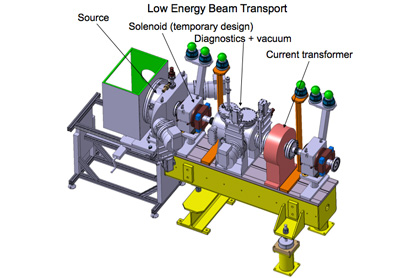The LHC toboggan run
Construction work has already begun on Linac4, the first link in a new proton accelerator chain to inject higher energy protons into the Large Hadron Collider. The next link in the chain is the Superconducting Proton Linac, a 500 metre-long tunnel that will accelerate the particles from Linac4.
“It’s a bit like a toboggan run,” says Richard Scrivens at CERN. The rest of the acceleration chain comprises circular accelerators, but the initial linear accelerator gives the physicists and engineers just one shot at controlling the particles. “In a circular machine, because the beam goes round and round it keeps coming back, so you can monitor and correct slight errors in acceleration,” he says. “In a linear accelerator the beam just goes down once. If you over-accelerate it at one stage there’s no opportunity to under-accelerate it later on – it goes past, it’s gone.”
That makes controlling the electrically charged particles as they are rapidly accelerated to energies of 5 gigaelectron volts more challenging. The acceleration is made with with klystrons and cavities. Each klystron generates an oscillating current in the radiofrequency range – the range also used to broadcast FM radio. The oscillating electromagnetic wave is injected and trapped in a cavity made of superconducting niobium, where the electric field of the wave becomes so strong it is able to quickly accelerate the charged particles. But klystrons are very expensive, says Scrivens. In an effort to cut the potential cost of the new linear accelerator, the research team is experimenting with using a smaller number of klystrons, each carefully controlling the beam at perhaps four points along the length of the collider.
Juggling Act
That’s something of a juggling act, he says. “In the past all other linear accelerators have used one klystron to control one cavity through which the beam passes,” he says. “We’re not sure yet how to control the oscillating field inside a cavity when one klystron might feed 4 cavities each with different requirements. It would be a big cost saving, but we have to prove it can be done.”
At the point that the beam is injected into the LHC ring itself it is in the form of protons – positively charged subatomic particles. But the particles accelerating along the Superconducting Proton Linac will be different, Scrivens says.
Negative hydrogen
“We are going to use a source of negative hydrogen,” he says. The negative hydrogen is formed from hydrogen gas in which each atom has an extra electron attached. The electrons are attached by making a plasma, in a device that is rather like a microwave.
The starting point is a small chamber just 5 cm across that is emptied of air to create a vacuum. Next a small quantity of hydrogen gas is injected and then a powerful electric current is sent through a coil surrounding the chamber, creating an electromagnetic field inside. Some electrons are injected into the back of the source, using an electron gun that is similar to a spark plug on a petrol engine. The electrons are then accelerated by the electromagnetic fields, and bombard the hydrogen molecules. Some of these molecules will then be ionised, meaning they lose an electron, and this forms a plasma with many more free electrons.
But more interestingly, some of the hydrogen molecules will be put into an excited state. These excited molecules then have a good chance of capturing an additional electron from the plasma, and disintegrating into both a hydrogen atom, and a negatively charged ion. It this negatively charged atom that is of interest for the source.
These negatively charged ions drift to the front of the source, where they can be pulled out of the plasma by a strong electric field, and are accelerated to 1% of the speed of light in less than 1cm.
Scrivens says using negative hydrogen will help to create the more intense, brighter beam that is the starting point for the LHC upgrade. The particles will be accelerated by the Superconducting Proton Linac, and injected into the first circular accelerator – the Proton Synchrotron 2 – in carefully controlled pulses so that they add to the particles already whizzing around the ring.
“If you try to do that using just protons, you can never put them exactly on top of the protons already in the machine – you have to put them next to the circulating beam of protons, which means you’re getting a more intense beam but it’s getting larger and larger,” he says. The negative hydrogen can sit neatly on top of the protons already in the ring, and that helps build up a more intense beam in the same volume.
The negative hydrogen and the protons then pass through a thin foil which strips away the electrons on the negatively charged beam, and converts it into protons. All of those protons will naturally repel each other, and it’s for that reason that all of the new accelerators will be higher in energy than those already in use. “The increase in energy means the beam is faster and more difficult to push apart,” says Scrivens.





